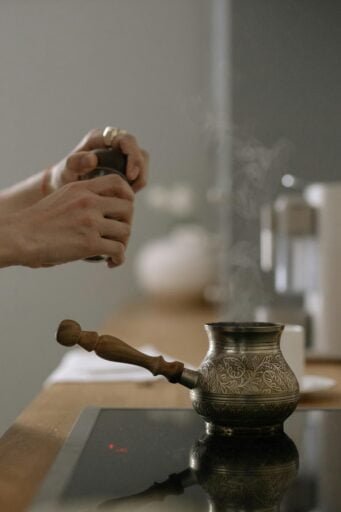Living with panic attacks can be incredibly overwhelming and distressing, leaving you feeling helpless and trapped. The constant fear of another attack can hinder your ability to enjoy life and pursue your goals. However, there are strategies you can implement to reduce the frequency and intensity of panic attacks. By understanding the root causes and implementing therapeutic techniques, you can regain control and experience a sense of calm. In this article, we will explore effective methods to help you reduce panic attacks and reclaim your peace of mind.
Understanding Panic Attacks
What are panic attacks?
Panic attacks are intense and sudden episodes of extreme anxiety and fear. They can happen without warning and may cause overwhelming physical sensations, such as a rapid heart rate, sweating, trembling, shortness of breath, and a sense of impending doom or loss of control. Panic attacks can be very distressing, making it difficult to function or engage in everyday activities.
Causes of panic attacks
Panic attacks can be triggered by various factors, including medical conditions, certain medications, substance abuse, and specific phobias. They may also occur due to a combination of genetic, biological, and environmental factors. Chronic stress, a history of trauma, and a family history of anxiety disorders can also increase the likelihood of experiencing panic attacks.
Symptoms of panic attacks
During a panic attack, you may experience a combination of physical and psychological symptoms. Physical symptoms can include a racing or pounding heart, feeling dizzy or lightheaded, shortness of breath, chest pain, sweating, trembling, and tingling or numbness in the hands or fingers. Psychological symptoms may include intense fear or terror, a sense of impending doom, feeling detached from reality, and a fear of losing control or going crazy. Panic attacks typically peak within a few minutes and gradually subside, but the effects can last for hours.
Seeking Professional Help
Importance of consulting a healthcare professional
If you experience panic attacks, it is crucial to seek professional help. A healthcare professional can evaluate your symptoms, provide an accurate diagnosis, and develop a personalized treatment plan to manage and reduce panic attacks. Professional help is essential in ensuring you have access to the necessary resources, guidance, and support on your journey towards recovery.
Types of healthcare professionals
Different healthcare professionals can assist in managing panic attacks. Psychiatrists are medical doctors who specialize in mental health conditions and can prescribe medications, if necessary. Psychologists are trained professionals who provide therapy and utilize various techniques, such as Cognitive Behavioral Therapy (CBT). Counselors and therapists can also offer talk therapy and provide valuable support throughout the treatment process.
Finding the right therapist or counselor
When seeking therapy, it is vital to find a therapist or counselor who specializes in anxiety disorders or panic attacks. Take the time to research and find someone with whom you feel comfortable and can establish a trusting relationship. Consider factors such as their qualifications, experience, therapeutic approach, and availability. It may also be helpful to seek recommendations from trusted friends, family, or healthcare providers.
Considerations for medication
Medication may be recommended in some cases to help manage panic attacks. Consult with a healthcare professional, such as a psychiatrist, to discuss the benefits and potential side effects of medication options. Medications commonly used to treat panic attacks include selective serotonin reuptake inhibitors (SSRIs), benzodiazepines, and beta blockers. It is essential to follow your healthcare professional’s guidance and closely monitor any changes or effects when taking medication.

Self-Help Techniques for Panic Attacks
Deep breathing exercises
Deep breathing exercises can help manage and reduce the intensity of panic attacks. Practice taking slow, deep breaths in through your nose and out through your mouth. Focus on filling your abdomen with each inhale and gradually releasing the breath with each exhale. This technique can help calm your mind and lower your heart rate, promoting a sense of relaxation.
Progressive muscle relaxation
Progressive muscle relaxation involves systematically tensing and relaxing different muscle groups in your body. Start by focusing on one muscle group, such as your hands, and tense the muscles for a few seconds, then release and relax them. Move slowly through each muscle group, working your way up your body. Progressive muscle relaxation helps alleviate muscle tension and promotes overall relaxation.
Grounding techniques
Grounding techniques can help anchor you to the present moment and reduce the severity of panic attacks. Focus on your immediate surroundings and engage your senses. Name five things you can see, four things you can touch, three things you can hear, two things you can smell, and one thing you can taste. By redirecting your thoughts to your sensory experience, grounding techniques can divert attention from panic symptoms.
Mindfulness and meditation
Practicing mindfulness and meditation can enhance your ability to manage and reduce panic attacks. Mindfulness involves focusing your attention on the present moment and accepting it without judgment. Meditation techniques, such as guided imagery or body scans, can help relax both your mind and body. Consistent practice of mindfulness and meditation can improve your overall emotional well-being and resilience.
Lifestyle Changes to Reduce Panic Attacks
Regular exercise
Engaging in regular exercise can significantly reduce the frequency and intensity of panic attacks. Physical activity releases endorphins, which are natural mood boosters. Choose activities that you enjoy, such as walking, jogging, swimming, or dancing. Aim for at least 30 minutes of moderate exercise most days of the week to promote overall well-being and reduce anxiety.
Balanced diet
A balanced diet plays a crucial role in promoting mental health and reducing panic attacks. Ensure that your diet includes a variety of whole foods, such as fruits, vegetables, lean proteins, whole grains, and healthy fats. Avoid excessive consumption of processed foods, sugary snacks, and caffeinated beverages, as they can exacerbate anxiety symptoms.
Adequate sleep
Getting enough sleep is essential for managing panic attacks. Establish a consistent sleep routine and aim for 7-9 hours of quality sleep each night. Create a relaxing bedtime routine, minimize exposure to screens before bed, and ensure your sleep environment is comfortable and conducive to restful sleep. Lack of sleep can increase stress levels and make you more susceptible to panic attacks.
Limiting caffeine and alcohol intake
Caffeine and alcohol can trigger or worsen anxiety symptoms. Limit your intake of caffeine, found in coffee, tea, energy drinks, and chocolate. Opt for decaffeinated alternatives or herbal teas. Similarly, alcohol can disrupt sleep patterns and may interact negatively with medications. Drink alcohol in moderation or consider avoiding it altogether to reduce the risk of panic attacks.

Identifying Triggers and Distracting Techniques
Identifying your triggers
Identifying triggers that contribute to panic attacks is a crucial step towards managing and reducing their occurrence. Pay attention to situations, thoughts, or activities that seem to precede your episodes. Common triggers may include crowded places, public speaking, certain social situations, or even specific thoughts or memories. Keeping a journal can help you track and identify patterns in your triggers.
Creating a panic attack toolkit
Create a panic attack toolkit that includes items and strategies to help you cope during episodes. This toolkit may include items such as a stress ball, calming essential oils, a soft blanket, or comforting music. Additionally, incorporate coping strategies, such as deep breathing exercises or grounding techniques, that work best for you. Having a panic attack toolkit readily available can provide a sense of security and support.
Engaging in distracting activities
Distracting activities can help shift your focus away from the overwhelming sensations of a panic attack. Find activities that hold your attention and provide a sense of calm. For some, this might involve reading a book, solving puzzles, engaging in creative hobbies, or listening to an engaging podcast. Experiment with different activities to discover what brings you relief and acts as a healthy distraction during panic attacks.
Cognitive Behavioral Therapy (CBT)
Overview of CBT
Cognitive Behavioral Therapy (CBT) is a widely recognized and effective treatment approach for anxiety disorders, including panic attacks. CBT aims to identify and modify negative thought patterns and behaviors that contribute to anxiety. It involves working collaboratively with a therapist to develop coping strategies, challenge irrational beliefs, and replace negative thoughts with positive ones. CBT provides practical tools to manage panic attacks and promotes long-term resilience.
Identifying negative thought patterns
One of the primary focuses of CBT is identifying negative thought patterns, known as cognitive distortions, that contribute to panic attacks. Examples of common cognitive distortions include catastrophizing (expecting the worst-case scenario), overgeneralization (drawing broad negative conclusions based on isolated incidents), and mind-reading (assuming what others are thinking without evidence). Recognizing these patterns can help you challenge and reframe your thoughts.
Challenging irrational beliefs
CBT encourages individuals to challenge their irrational beliefs and examine the evidence supporting them. This process involves questioning the validity and accuracy of thoughts that may contribute to panic attacks. By objectively evaluating the evidence and considering alternative explanations, you can gradually replace irrational beliefs with more rational and realistic ones, reducing anxiety.
Replacing negative thoughts with positive ones
Once you have identified negative thought patterns and challenged irrational beliefs, CBT helps you develop healthier, more positive thinking patterns. This process involves consciously replacing negative thoughts with positive affirmations and statements. By reframing your thinking, you can change your emotional response to stressful situations and reduce the likelihood of panic attacks.

Relaxation Techniques for Panic Attacks
Using visualization techniques
Visualization techniques involve creating mental images that promote relaxation and a sense of calm. Close your eyes and imagine yourself in a peaceful setting, such as a beach or a serene forest. Picture the sights, sounds, and smells associated with this place. Allow yourself to fully immerse in the calming imagery, focusing on creating a sense of tranquility and safety.
Listening to calming music
Music has a powerful effect on our emotions and can be a valuable tool in managing panic attacks. Create a playlist of calming, soothing music that you find comforting. When experiencing a panic attack, listen to this playlist to help distract your mind and promote a sense of relaxation. Choose music that resonates with you personally and brings about a sense of peace.
Practicing yoga or tai chi
Yoga and tai chi are mind-body practices that combine gentle movements with focused breathing and meditation. These practices can help reduce anxiety and promote relaxation. Yoga and tai chi classes often incorporate specific postures, breathing exercises, and mindfulness techniques that can be beneficial in managing panic attacks. Regular practice can provide long-term benefits for your mental and physical well-being.
Taking warm baths or showers
Warm baths or showers can be calming and mentally soothing. The warm water can help relax tense muscles and release any physical tension associated with panic attacks. Incorporate aromatherapy by adding a few drops of essential oils, such as lavender or chamomile, known for their calming properties. Take your time to indulge in this self-care routine and allow the warm water to wash away stress and anxiety.
Support Networks and Peer Groups
The importance of support networks
Building a support network is crucial in managing panic attacks. Surrounding yourself with understanding and empathetic individuals can provide emotional support and help alleviate feelings of isolation. Share your experiences and struggles with trusted family members, friends, or support groups. Knowing that you are not alone and having people who can listen without judgment can be immensely comforting.
Joining peer support groups
Peer support groups bring together individuals who have similar experiences with panic attacks or anxiety disorders. These groups provide a safe and non-judgmental environment to share experiences, exchange coping strategies, and offer mutual support. Seeking out local or online peer support groups can provide a sense of community and validation, fostering a supportive environment for your journey towards managing panic attacks.
Online resources and communities
In addition to traditional support networks, online resources and communities can be valuable sources of information and support. Numerous websites, forums, and social media groups are dedicated to anxiety disorders and panic attacks. Engage in online discussions, share your thoughts, and learn from others who have successfully managed their panic attacks. Remember to approach online platforms with caution and prioritize reputable sources of information.
Stress Management Techniques
Identifying sources of stress
Identifying and managing stressors is essential in reducing panic attacks. Reflect on the circumstances and situations that frequently trigger stress or anxiety for you. It may be related to work, relationships, financial concerns, or other aspects of your life. By pinpointing the specific sources of stress, you can take proactive steps to address and manage them effectively.
Healthy coping mechanisms
Adopting healthy coping mechanisms can help mitigate the impact of stress on panic attacks. Explore activities or techniques that promote relaxation and stress relief for you personally. This can include engaging in hobbies such as painting, playing a musical instrument, or taking nature walks. Establish a routine that incorporates self-care and stress-reducing practices, such as dedicating time for relaxation, exercise, or connecting with loved ones.
Time management strategies
Effective time management can significantly reduce stress and create a sense of control over your daily life. Prioritize tasks and responsibilities, and break them down into manageable steps. Delegate when necessary and avoid overloading yourself with unrealistic expectations. By managing your time effectively, you can create a balanced and less stressful lifestyle, minimizing the triggers for panic attacks.
Promoting Emotional Well-being
Expressing emotions through journaling
Journaling provides an outlet to express and process your emotions. Set aside dedicated time each day to write down your thoughts and feelings. Use your journal to explore the underlying causes of your panic attacks, track your progress, and celebrate your achievements. Writing can be therapeutic and aids in gaining insight and self-reflection, promoting emotional well-being.
Engaging in hobbies and activities
Engaging in hobbies and activities that bring you joy and fulfillment is essential for emotional well-being. Dedicate time to participate in activities that you enjoy, whether it’s painting, dancing, gardening, or playing a musical instrument. Immerse yourself in the present moment and allow yourself to experience pleasure and a sense of accomplishment. Hobbies and activities provide a healthy outlet for emotions and can help reduce anxiety.
Seeking professional therapy
Professional therapy, such as individual counseling or psychotherapy, can be instrumental in promoting emotional well-being. Therapists provide a safe and supportive environment to explore underlying emotional issues, develop coping strategies, and support you throughout your journey. Therapy offers a non-judgmental space to process emotions, gain insight, and learn valuable tools for managing panic attacks.
Practicing self-compassion
Practicing self-compassion is crucial when experiencing panic attacks. Be gentle and kind to yourself, recognizing that panic attacks are not your fault and do not define your worth. Treat yourself with the same empathy and understanding you would offer to a loved one. Practice self-care by prioritizing your well-being, setting boundaries, and engaging in activities that nurture your emotional health. By fostering self-compassion, you can support your emotional well-being and cultivate resilience in the face of panic attacks.
In conclusion, managing and reducing panic attacks requires a comprehensive approach that addresses the physical, psychological, and emotional aspects of this condition. Seeking professional help, implementing self-help techniques, making lifestyle changes, identifying triggers, and engaging in stress management strategies can all contribute to alleviating panic attacks and promoting overall well-being. Remember, you are not alone in this journey, and with the right support and tools, you can effectively manage and reduce panic attacks.